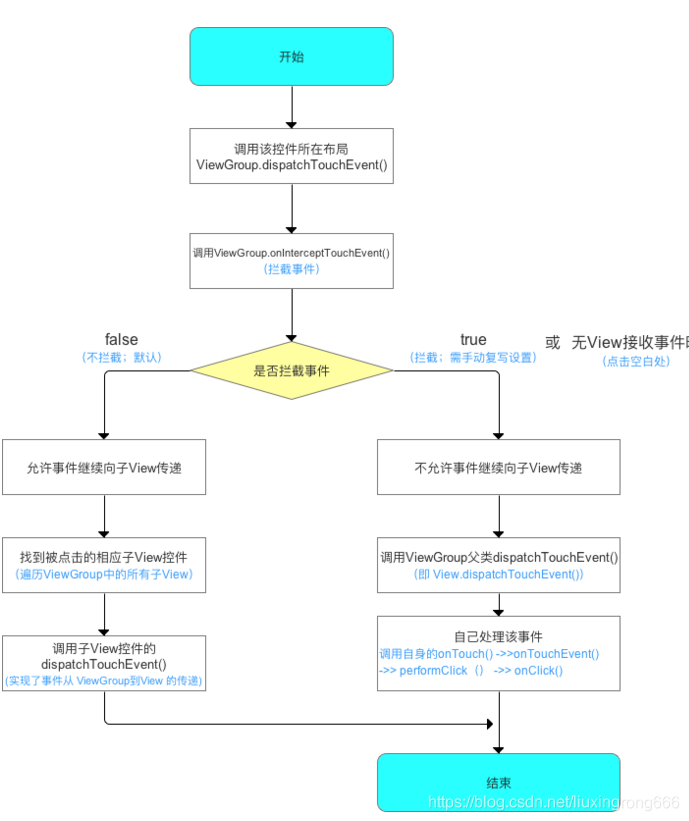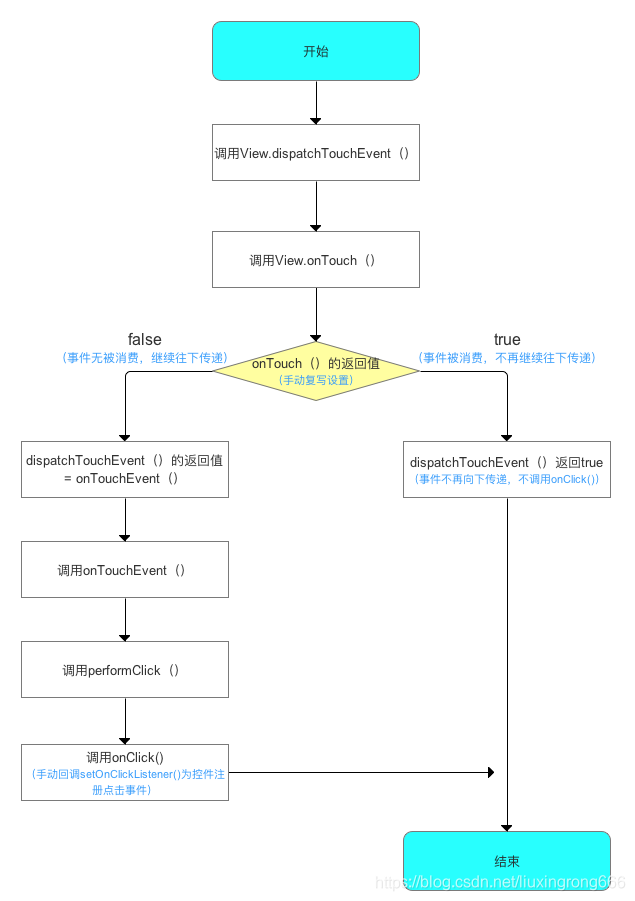View的事件分发机制是Android中的一个难点,也是非常重要的知识点,充分理解和掌握事件分发机制有助于我们在自定义View的时候更好地分析和解决问题
整体上来看,View事件的大致传递顺序是Activity->Window->ViewGroup->View,首先到activity的dispatchTouchEvent,然后到Activity内部的Window,Window再传递给DecorView,由DecorView再到顶级View,顶级View是我们在Activity中用setContentView设置的View,一般是一个ViewGroup,ViewGroup又会把事件分发给它的子view,当然子view可以是ViewGroup也可以是View
dispatchTouchEvent是可以说是所有事件分发的入口函数,其中ViewGroup和View都有dispatchTouchEvent方法,但是它们对事件的处理逻辑是完全不一样的,这里先从ViewGroup的dispatchTouchEvent方法开始分析
ViewGroup的dispatchTouchEvent方法,源码如下:
public boolean dispatchTouchEvent(MotionEvent ev) {
// 省略部分代码..............
// Check for interception.
// mFirstTouchTarget 代表是否有子view消费了事件
final boolean intercepted; //是否拦截事件
//在允许拦截事件的情况下,view的down事件都会调用onInterceptTouchEvent方法,询问是否
//需要拦截事件,还有就是有子view消费事件的时候,也会调用onInterceptTouchEvent方法
//如果没有子view消费事件,代表没必要分发事件了,直接intercepted为true拦截事件
if (actionMasked == MotionEvent.ACTION_DOWN
|| mFirstTouchTarget != null) {
//是否允许拦截事件,可以自己设置
final boolean disallowIntercept = (mGroupFlags & FLAG_DISALLOW_INTERCEPT) != 0;
if (!disallowIntercept) { //允许拦截
//调用了拦截事件的方法,返回Boolean代表是否拦截事件,ViewGroup一般默认不拦截事件,返回false,
//可以重写此方法返回true代表拦截,然后事件将不再往下分发
intercepted = onInterceptTouchEvent(ev);
ev.setAction(action); // restore action in case it was changed
} else {
intercepted = false;
}
} else {
// 意思就是当前事件不是down事件并且没有子view消费,所有此viewgroup直接拦截事件
// 也可以这么理解,一开始down事件分发下去,然而下一级view并没有消费事件,那么
// 此后的其他事件如move、up都不再分发给下一级了
// There are no touch targets and this action is not an initial down
// so this view group continues to intercept touches.
intercepted = true;
}
//如果事件没有取消并且viewgroup不拦截事件,则执行事件的分发
if (!canceled && !intercepted) {
// 省略部分代码...................
//循环遍历ViewGroup的子view,逐一询问子view是否消费事件
final int childrenCount = mChildrenCount; //子view个数
//
if (newTouchTarget == null && childrenCount != 0) {
final float x = ev.getX(actionIndex);
final float y = ev.getY(actionIndex);
// Find a child that can receive the event.
// Scan children from front to back.
final ArrayList<View> preorderedList = buildTouchDispatchChildList();
final boolean customOrder = preorderedList == null
&& isChildrenDrawingOrderEnabled();
final View[] children = mChildren;
//循环遍历子view,从最后添加的子view开始,代表先分发给后添加的子view
for (int i = childrenCount - 1; i >= 0; i--) {
final int childIndex = getAndVerifyPreorderedIndex(
childrenCount, i, customOrder);
final View child = getAndVerifyPreorderedView(
preorderedList, children, childIndex);
// If there is a view that has accessibility focus we want it
// to get the event first and if not handled we will perform a
// normal dispatch. We may do a double iteration but this is
// safer given the timeframe.
if (childWithAccessibilityFocus != null) {
if (childWithAccessibilityFocus != child) {
continue;
}
childWithAccessibilityFocus = null;
i = childrenCount - 1;
}
if (!canViewReceivePointerEvents(child)
|| !isTransformedTouchPointInView(x, y, child, null)) {
ev.setTargetAccessibilityFocus(false);
continue;
}
newTouchTarget = getTouchTarget(child);
if (newTouchTarget != null) {
// Child is already receiving touch within its bounds.
// Give it the new pointer in addition to the ones it is handling.
newTouchTarget.pointerIdBits |= idBitsToAssign;
break;
}
resetCancelNextUpFlag(child);
//方法dispatchTransformedTouchEvent是将事件分发给当前child,返回值代表child是否消费了事件,
//如果为true代表子view消费了事件,此时将跳出循环结束事件的分发,如果为false,代表子view没有消费事件,那么将继续分发给下一个子view
if (dispatchTransformedTouchEvent(ev, false, child, idBitsToAssign)) {
// Child wants to receive touch within its bounds.
mLastTouchDownTime = ev.getDownTime();
if (preorderedList != null) {
// childIndex points into presorted list, find original index
for (int j = 0; j < childrenCount; j++) {
if (children[childIndex] == mChildren[j]) {
mLastTouchDownIndex = j;
break;
}
}
} else {
mLastTouchDownIndex = childIndex;
}
mLastTouchDownX = ev.getX();
mLastTouchDownY = ev.getY();
//因为有子view消费了事件,所以给newTouchTarget 赋值
newTouchTarget = addTouchTarget(child, idBitsToAssign);
alreadyDispatchedToNewTouchTarget = true;
break; //跳出循环
}
// The accessibility focus didn't handle the event, so clear
// the flag and do a normal dispatch to all children.
ev.setTargetAccessibilityFocus(false);
}
if (preorderedList != null) preorderedList.clear();
}
// 循环结束
if (newTouchTarget == null && mFirstTouchTarget != null) {
// Did not find a child to receive the event.
// Assign the pointer to the least recently added target.
newTouchTarget = mFirstTouchTarget;
while (newTouchTarget.next != null) {
newTouchTarget = newTouchTarget.next;
}
newTouchTarget.pointerIdBits |= idBitsToAssign;
}
}
}
// Dispatch to touch targets.
//没有子view消费事件或viewgroup直接拦截事件
if (mFirstTouchTarget == null) { //当viewgroup拦截事件的时候也会执行这里
// dispatchTransformedTouchEvent中会调用viewgroup父类即View的dispatchTouchEvent方法,代表由ViewGroup自身消费此事件
// No touch targets so treat this as an ordinary view.
handled = dispatchTransformedTouchEvent(ev, canceled, null,
TouchTarget.ALL_POINTER_IDS);
} else {
// Dispatch to touch targets, excluding the new touch target if we already
// dispatched to it. Cancel touch targets if necessary.
TouchTarget predecessor = null;
TouchTarget target = mFirstTouchTarget;
while (target != null) {
final TouchTarget next = target.next;
//如果事件已经传递并且被当前子view消费的,那么就handled为true,那么当前方法就返回true
if (alreadyDispatchedToNewTouchTarget && target == newTouchTarget) {
handled = true;
} else { //处理事件被cancel的情况
final boolean cancelChild = resetCancelNextUpFlag(target.child)
|| intercepted;
if (dispatchTransformedTouchEvent(ev, cancelChild,
target.child, target.pointerIdBits)) {
handled = true;
}
if (cancelChild) {
if (predecessor == null) {
mFirstTouchTarget = next;
} else {
predecessor.next = next;
}
target.recycle();
target = next;
continue;
}
}
predecessor = target;
target = next;
}
}
// Update list of touch targets for pointer up or cancel, if needed.
if (canceled
|| actionMasked == MotionEvent.ACTION_UP
|| actionMasked == MotionEvent.ACTION_HOVER_MOVE) {
resetTouchState();
} else if (split && actionMasked == MotionEvent.ACTION_POINTER_UP) {
final int actionIndex = ev.getActionIndex();
final int idBitsToRemove = 1 << ev.getPointerId(actionIndex);
removePointersFromTouchTargets(idBitsToRemove);
}
}
if (!handled && mInputEventConsistencyVerifier != null) {
mInputEventConsistencyVerifier.onUnhandledEvent(ev, 1);
}
return handled;
}
在ViewGroup的dispatchTouchEvent方法中,首先通过onInterceptTouchEvent方法的返回值来询问是否需要拦截事件,如果要拦截事件,则事件就由当前ViewGroup消费而不再往下分发,如果不拦截事件,则分发给下面的子view
在源码中可以看到,ViewGroup通过循环遍历它的所有子view,逐一询问子view是否消费此事件,如果子view消费了事件,则返回true,跳出循环,当子view不消费事件则返回false,继续遍历询问下一个子view,如果所有的子view都不消费事件,则会调用viewgroup父类即view的onTouchEvent方法,代表viewgroup自己消费此事件,通过dispatchTransformedTouchEvent方法来实现
dispatchTransformedTouchEvent源码如下:
private boolean dispatchTransformedTouchEvent(MotionEvent event, boolean cancel,
View child, int desiredPointerIdBits) {
final boolean handled;
// Canceling motions is a special case. We don't need to perform any transformations
// or filtering. The important part is the action, not the contents.
final int oldAction = event.getAction();
if (cancel || oldAction == MotionEvent.ACTION_CANCEL) {
event.setAction(MotionEvent.ACTION_CANCEL);
if (child == null) {
// 当viewgroup的所有子view都不消费事件的时候,参数child就为null
handled = super.dispatchTouchEvent(event);
} else {
handled = child.dispatchTouchEvent(event);
}
event.setAction(oldAction);
return handled;
}
当ViewGroup的遍历子view完成以后,如果没有子view消费事件或者当前ViewGroup根本就没有子view,那么下面的mFristTouchTarget将等于null,在dispatchTransformedTouchEvent方法中的参数child将传null值,然后调用super.dispatchTouchEvent方法,此时事件就由ViewGroup自己消费
if (mFirstTouchTarget == null) {
// No touch targets so treat this as an ordinary view.
handled = dispatchTransformedTouchEvent(ev, canceled, null,
TouchTarget.ALL_POINTER_IDS);
} else {
//省略代码..................
}
上面分析完了ViewGroup的dispatchTouchEvent方法,这是一个ViewGroup的事件分发流程图:

分析了ViewGroup的事件分发,接下来我们分析View的dispatchTouchEvent方法,因为View是ViewGroup的父类,所以View的dispatchTouchEvent既代表了View的事件处理机制,也代表了在某些情况下ViewGroup的事件处理机制;
以我的总结,View的这个方法在以下三种情况会被调用,一是ViewGroup分发事件但是没有子view消费事件,二是ViewGroup本来就没有子view,三是控件是View而不是ViewGroup;代码如下:
//view的处理事件的方法
public boolean dispatchTouchEvent(MotionEvent event) {
// If the event should be handled by accessibility focus first.
if (event.isTargetAccessibilityFocus()) {
// We don't have focus or no virtual descendant has it, do not handle the event.
if (!isAccessibilityFocusedViewOrHost()) {
return false;
}
// We have focus and got the event, then use normal event dispatch.
event.setTargetAccessibilityFocus(false);
}
boolean result = false;
if (mInputEventConsistencyVerifier != null) {
mInputEventConsistencyVerifier.onTouchEvent(event, 0);
}
final int actionMasked = event.getActionMasked();
if (actionMasked == MotionEvent.ACTION_DOWN) {
// Defensive cleanup for new gesture
stopNestedScroll();
}
if (onFilterTouchEventForSecurity(event)) {
if ((mViewFlags & ENABLED_MASK) == ENABLED && handleScrollBarDragging(event)) {
result = true;
}
//如果设置mOnTouchListener监听,优先将事件交给onTouch方法处理
//noinspection SimplifiableIfStatement
ListenerInfo li = mListenerInfo;
if (li != null && li.mOnTouchListener != null
&& (mViewFlags & ENABLED_MASK) == ENABLED
&& li.mOnTouchListener.onTouch(this, event)) {
result = true;
}
//如果没有设置onTouch方法,则将事件交给onTouchEvent方法处理,可见onTouch方法的优先级是最高的
if (!result && onTouchEvent(event)) {
// 看onTouchEvent是否消费事件
result = true;
}
}
if (!result && mInputEventConsistencyVerifier != null) {
mInputEventConsistencyVerifier.onUnhandledEvent(event, 0);
}
// Clean up after nested scrolls if this is the end of a gesture;
// also cancel it if we tried an ACTION_DOWN but we didn't want the rest
// of the gesture.
if (actionMasked == MotionEvent.ACTION_UP ||
actionMasked == MotionEvent.ACTION_CANCEL ||
(actionMasked == MotionEvent.ACTION_DOWN && !result)) {
stopNestedScroll();
}
return result;
}
如果View设置了onTouchListener监听,会优先将事件先交由onTouch方法处理,如果没有或者onTouch返回false,则交给onTouchEvent处理,看看onTouchEvent方法的部分源码:
public boolean onTouchEvent(MotionEvent event) {
final float x = event.getX();
final float y = event.getY();
final int viewFlags = mViewFlags;
final int action = event.getAction();
//是否可以点击
final boolean clickable = ((viewFlags & CLICKABLE) == CLICKABLE
|| (viewFlags & LONG_CLICKABLE) == LONG_CLICKABLE)
|| (viewFlags & CONTEXT_CLICKABLE) == CONTEXT_CLICKABLE;
//省略代码。。。。。。。。。。。。。。。。。
// 若view可点击或者可长按以及长按出现ToolTip
// 8.0新加的TOOLTIP,解释当前的View是干什么的,可以在View中设置 android:tooltipText=""设置,长按View会出现提示""设置的提示信息,所以这里和clickable平级“或”的关系
if (clickable || (viewFlags & TOOLTIP) == TOOLTIP) {
switch (action) {
// 在ACTION_UP的时候会执行点击事件
case MotionEvent.ACTION_UP:
mPrivateFlags3 &= ~PFLAG3_FINGER_DOWN;
if ((viewFlags & TOOLTIP) == TOOLTIP) {
handleTooltipUp();
}
if (!clickable) {
removeTapCallback();
removeLongPressCallback();
mInContextButtonPress = false;
mHasPerformedLongPress = false;
mIgnoreNextUpEvent = false;
break;
}
boolean prepressed = (mPrivateFlags & PFLAG_PREPRESSED) != 0;
if ((mPrivateFlags & PFLAG_PRESSED) != 0 || prepressed) {
// take focus if we don't have it already and we should in
// touch mode.
boolean focusTaken = false;
if (isFocusable() && isFocusableInTouchMode() && !isFocused()) {
focusTaken = requestFocus();
}
if (prepressed) {
// The button is being released before we actually
// showed it as pressed. Make it show the pressed
// state now (before scheduling the click) to ensure
// the user sees it.
setPressed(true, x, y);
}
if (!mHasPerformedLongPress && !mIgnoreNextUpEvent) {
// This is a tap, so remove the longpress check
removeLongPressCallback();
// Only perform take click actions if we were in the pressed state
if (!focusTaken) {
// Use a Runnable and post this rather than calling
// performClick directly. This lets other visual state
// of the view update before click actions start.
if (mPerformClick == null) {
mPerformClick = new PerformClick();
}
//执行点击事件
if (!post(mPerformClick)) {
performClick();
}
}
}
if (mUnsetPressedState == null) {
mUnsetPressedState = new UnsetPressedState();
}
if (prepressed) {
postDelayed(mUnsetPressedState,
ViewConfiguration.getPressedStateDuration());
} else if (!post(mUnsetPressedState)) {
// If the post failed, unpress right now
mUnsetPressedState.run();
}
removeTapCallback();
}
mIgnoreNextUpEvent = false;
break;
//省略代码。。。。。。。。。。。。。。。。
}
// 代表消费了事件
return true;
}
// 返回false代表不消费事件
return false;
}
分析一下点击事件是如何响应的,首先判断当前View是否为可点击的,一般来说ViewGroup默认是不可点击的,所以一般ViewGroup的onTouchEvent方法返回false,所以ViewGroup一般默认是不消费事件的,如果是可点击则执行performClick方法,onTouchEvent就会返回true,所以对于view来说,只要它是可点击或者可长按的,都会消费事件并返回true,比如Button、ImageView、ImageButton等控件都会消费事件
这是一个View的事件分发流程图:

通过上面的总结分析,我们掌握ViewGroup和View的dispatchTouchEvent方法的事件分发机制,总结一下自定义view中关于事件分发的常见需求:
1.如果想在ViewGroup中拦截事件并且不让事件向下分发,可以重写onInterceptTouchEvent方法并返回true,然后事件会交给onTouchEvent方法处理,通过重写onTouchEvent方法来处理事件
2.如果我们需要在ViewGroup中处理事件,但是不拦截事件,那么就重写dispatchTouchEvent方法,在此方法中获取事件
3.处理滑动冲突的时候,可以重写onInterceptTouchEvent方法,根据具体业务逻辑判断是否拦截事件,也可以重写dispatchTouchEvent方法,所有事件先传给子view,如果子view需要就消费,不需要就返回给父容器的onTouchEvent消费







 本文详细解析了Android中View的事件分发机制,包括Activity到View的传递顺序,重点分析了ViewGroup和View的dispatchTouchEvent方法。讨论了如何在自定义View中拦截和处理事件,以及解决滑动冲突的策略。
本文详细解析了Android中View的事件分发机制,包括Activity到View的传递顺序,重点分析了ViewGroup和View的dispatchTouchEvent方法。讨论了如何在自定义View中拦截和处理事件,以及解决滑动冲突的策略。
















 184
184

 被折叠的 条评论
为什么被折叠?
被折叠的 条评论
为什么被折叠?








